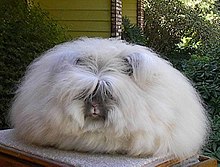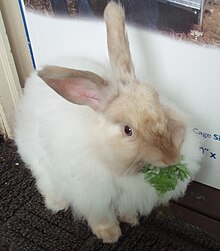The Angora rabbit is a variety of domestic rabbit bred for its long, soft hair. The Angora is one of the oldest types of domestic rabbit, originating in Ankara, Turkey, along with the Angora cat and Angora goat. The rabbits were popular pets with French royalty in the mid 1700s, and spread to other parts of Europe by the end of the century. They first appeared in the United States in the early 1900s. They are bred largely for their long Angora wool, which may be removed by shearing, combing, or plucking. There are many individual breeds of Angora rabbits, four of which are ARBA recognized.They are English, French, Giant and Satin. Other breeds include German, Chinese, Swiss and Finnish, to name a few.
Coat and appearance
Angoras are bred mainly for their wool because it is silky and soft. They have a humorous appearance, as they oddly resemble a fur ball. Most are calm and docile but should be handled carefully. Grooming is necessary to prevent the fibre from matting and felting on the rabbit. A condition "wool block" is common in angora rabbits and should be treated quickly.[1] These rabbits are shorn every three to four months throughout the year.
Medical Considerations
Rabbits are unique because they do not possess the same allergy-causing qualities as many other animals. The average rabbit can live for about 5-7 years when kept indoors and well-cared for. However, many outdoors rabbits have a shorter lifespan. Maintenance is a must. The Satin Angora has a much lower guard hair count and their wool becomes easy tangled. Regardless of breed, all Angoras must be monitored to prevent wool block, a condition where their innards become clogged with hair.
Breeds
There are four different ARBA-recognized Angora rabbit breeds: English, French, Giant and Satin. The German Angora is also common, but is not ARBA recognized. It has its own association; the IAGARB.
English
- Weight: 2.0–3.5 kg (4.4–7.7 lb).
- ARBA-accepted varieties: Ruby Eye White, Pointed White, Self, Shaded, Agouti
Prior to the 1939, there was one breed of "Angora Wooler". In 1939, ARBA reclassified "Angora Wooler" into "English Type" and "French Type". In 1944, ARBA officially separate Angora rabbit into two breeds: English Angora and French Angora.
Rabbits of the angora breed are adorned with "fur," growths of wool on the ears and the entire face except above the nose, and front feet, along with their thick body, and wool. They are gentle in nature, but they are not recommended for those who do not groom their animals. Their wool is very thick and needs to be groomed twice a week.
This is the smallest Angora rabbit of the four breeds recognized by ARBA. This breed is more common as a pet because of the facial features that give it a puppy dog or teddy bear look. If the texture of the wool is correct, the maintenance is relatively easy; if the texture of the rabbit is cottony, it requires a great deal of maintenance.
The English angora can be bred to have broken colors, (ex: the rabbit is white with black spots.) This is not accepted by ARBA standards and would lead to a disqualification when showing the rabbit. When showing an English angora rabbit the toe nails should also be only one color, the ears could be folded over at the tips, and the furnishings on the face may cover their eyes.
French
- Weight: 3.5–4.5 kg (7.7–9.9 lb).
- ARBA-accepted varieties: Agouti, Pointed White, Self, Shaded, Ticked, Wide Band, and Broken.
This breed has a preponderance of guard hair on the surface, with wool as an undercoat. If the texture is correct, it requires less maintenance than other Angora breeds. Small ear tufts are allowed but not usually preferred by breeders. ARBA recognizes the same colors as with English Angora, plus broken. They are shown at ARBA shows using the types "white" and "colored" (broken being a colored). As with other ARBA shown rabbits toe nails should also be only one color.
The French Angora is one of the large Angora breeds at 7 1/2 to 10 lbs, with a commercial body type. It differs from the English, Giant and German Angora in that it possesses a clean face and front feet with only minor tufting on the rear legs. The color of a French Angora is determined by the color of its head, feet and tail (all the same color)
German
- Weight: 2.0–5.5 kg (4.4–12 lb).
- IAGARB-accepted varieties: all (not subject to ARBA standards)
This breed, while not ARBA recognized, is common in the United States and Canada. It looks much like the Giant Angora, the majority of German angora are ruby-eyed white or albino. Back in 2006 several Black German Angora were imported to the USA and Canada.
Many hand spinners have bred the German Angora with another type of colored angora (or non angora in some cases) in effort to acquire color in the more dense non-matting German- type wool. These resulting rabbits are called German crosses; not to be confused with the rabbits called German angora hybrids. Briefly explained, a German Hybrid is a rabbit that when you look at its 3 generation pedigree there are only 100% German angoras listed as ancestors.
A separate association for German angoras exists called the International Association of German Angora Rabbit Breeders, or IAGARB. Instead of conformation showing, the emphasis is on both the wool bearing properties & the body type charactaristics of the rabbit for commercial purposes. The rabbit must meet objective standards and perform well on 90 day shearing tests in order to be officially recognized as a registered German angora rabbit.
IAGARB will now also recognize colored [hybrid] German angora rabbits; and they may achieve a German registration if they conform to the IAGARB breed standard and prove their wool bearing ability by passing the Judges testing via 90 day wool shearing tests. Since IAGARB registration is independent of parentage or ancestry, any REW (ruby-eyed-white) or colored angora rabbit that meets the registration standards of the club can be registered as a German Angora. The notion that they come only in white is a common misconception, as the rules have recently been changed to include colored angoras as well as ruby eyed white.
Giant
- Weight: 4.5 kg (9.9 lb) or larger
- ARBA-accepted varieties: Ruby-Eyed White
The Giant Angora is the largest of the ARBA accepted angora breeds, having been created by Louise Walsh to be an efficient wool producing rabbit sustained with 16-18% alfalfa based rabbit feed & hay and living in the standard size all wire cages used for commercial breeds. Its coat contains three types of wool: under wool, awl, and guard hair; the awl type wool exists only on the giant and German angora. This breed should have furnishings on the face and ears. Many people confuse German angora with Giant angora, but they are not the same.
This is the largest of the four ARBA recognized Angora breeds. The only color ARBA officially recognizes for Giant angora is REW (Ruby Eyed White), or as more commonly referred to as an "albino"-indicating the absence of color pigment in the genetic makeup. The Giant Angora produces more wool than the French, Satin or English Angora. Like the German angora Giant Angora rabbits do not molt; And like the German Angora, they require their wool to be clipped or shorn off at least once every 90 days.
Since rabbits ingest their wool when they groom themselves clipping off of their wool at least once every 90 days is considered a must in order to prevent "wool block" from occurring. the wool swallowed by the rabbit can not be coughed or vomited up and will cause the rabbit to slowly starve to death as its digestive system and intestinal tract fill up with their ingested wool, if left untreated wool block can lead to death. It is widely held among serious angora breeders that along with ample cage space to exercise and feeding fresh horse quality hay on a daily basis will help keep the wool moving through the system and prevent wool block. it is also widely held that feeding both bromaline (found in fresh pineapple) and papaya occasionally will aid in breaking down the ingested wool, and aiding in its passage through the rabbits system.
Like many other "giant" breeds of rabbits the Giant Angora grows slowly. A senior doe usually takes 1+ yr to reach full maturity (size and weight). A senior buck, can take up to 1.5 years to fully mature (size and weight).
Satin
- Weight: 3.0–4.5 kg (6.6–9.9 lb).
- ARBA-accepted varieties: Agouti, Pointed White, Self, Shaded, Ticked, Wide Band
The Satin Angora is derived from a cross between a Satin and a French Angora. This breed is named for the extremely soft texture of its wool. It has no furnishings on face, ears, or feet, and it is also easy to groom compared to the English variety. Satin Angora's wool is said to be stronger for spinning than other varieties of Angora.
They are shown at ARBA shows using the types "white" and "colored"(broken not approved). As with other ARBA shown rabbits toe nails should also be only one color. The color of a Satin Angora is determined by the color of its head, feet and tail (all the same color).
This breed does not produce as much wool as other breeds of Angora rabbits. This trait is being improved upon by selective breeding. The wool should have a silky texture with good guard hair for ease of maintenance.












0 comments:
Post a Comment